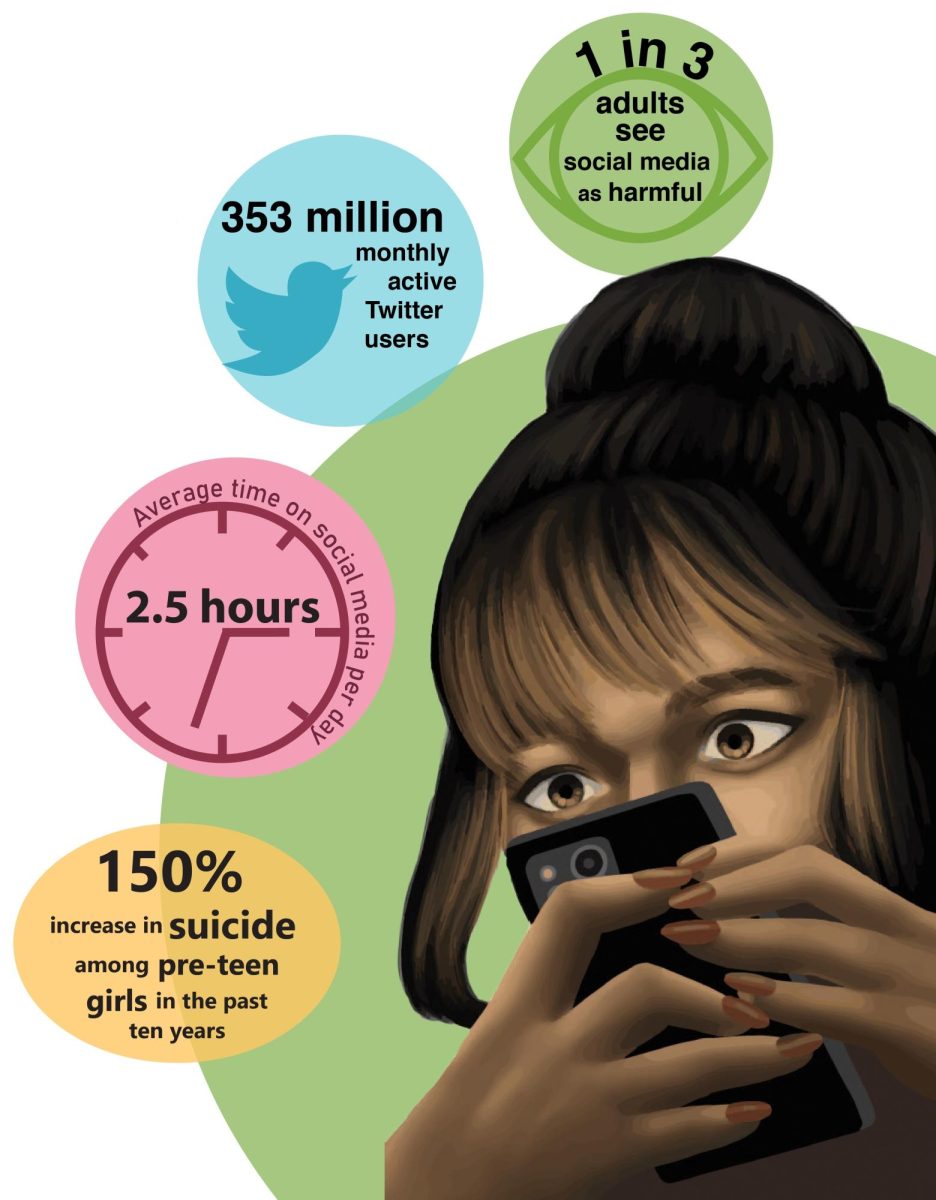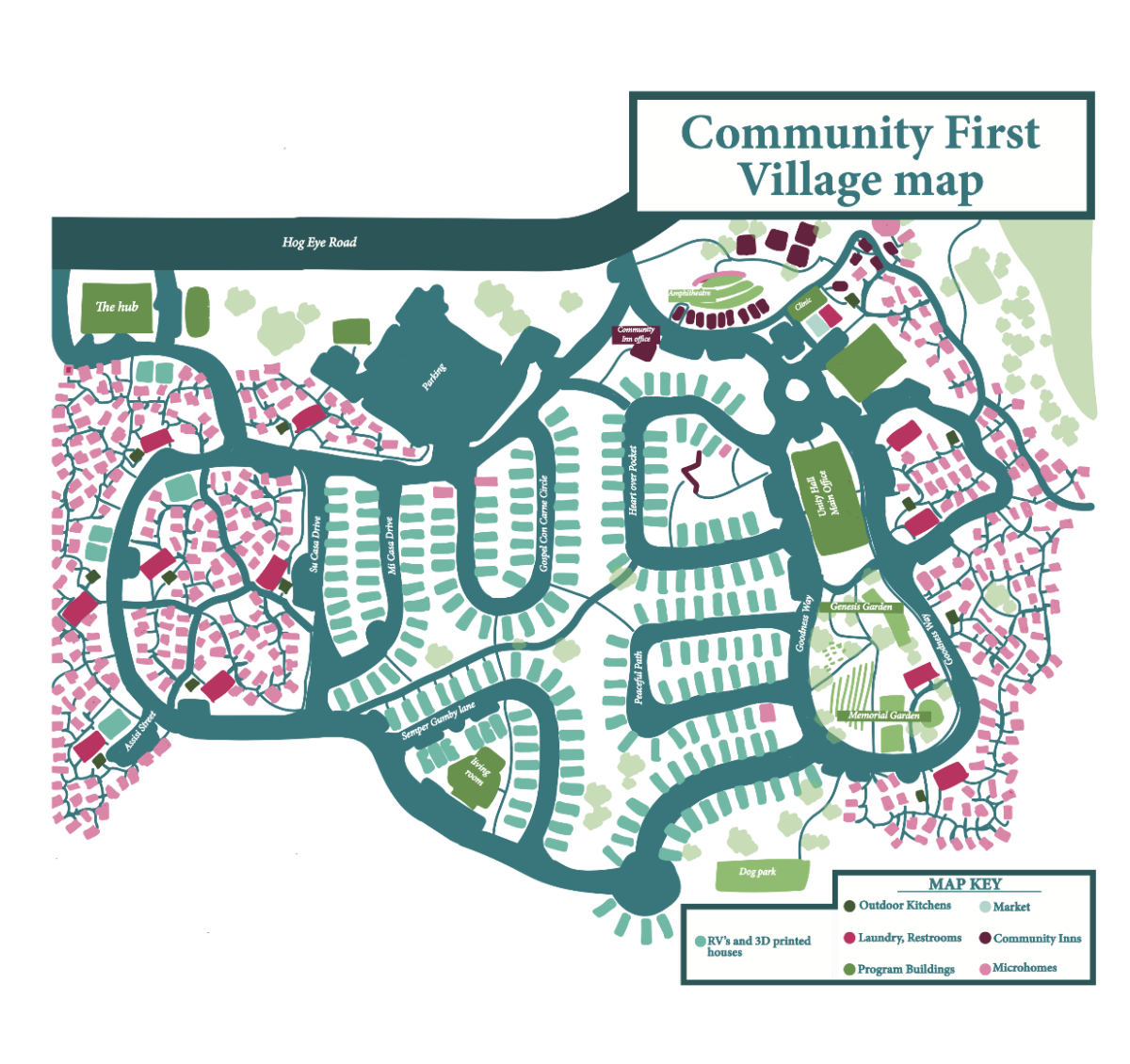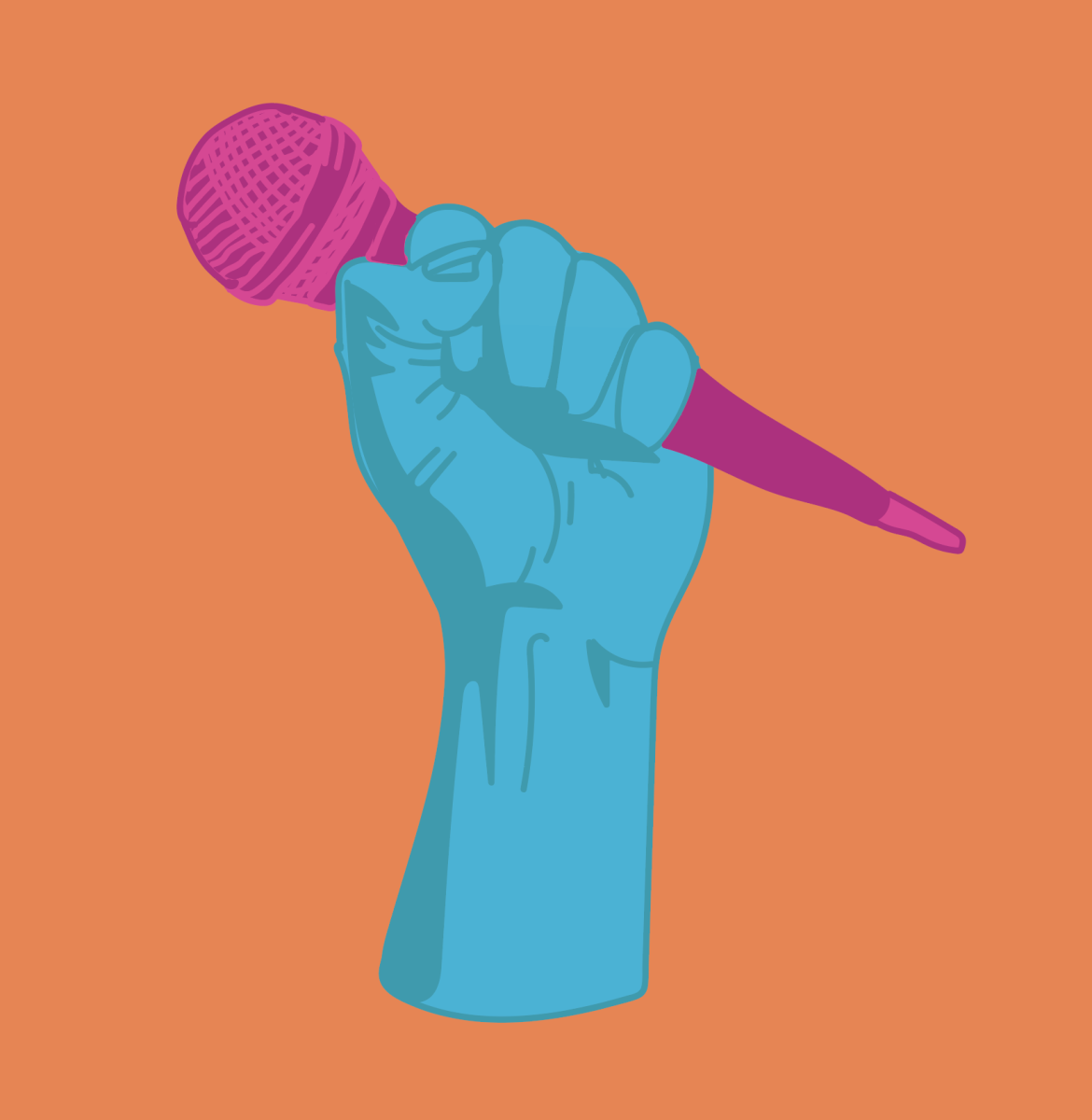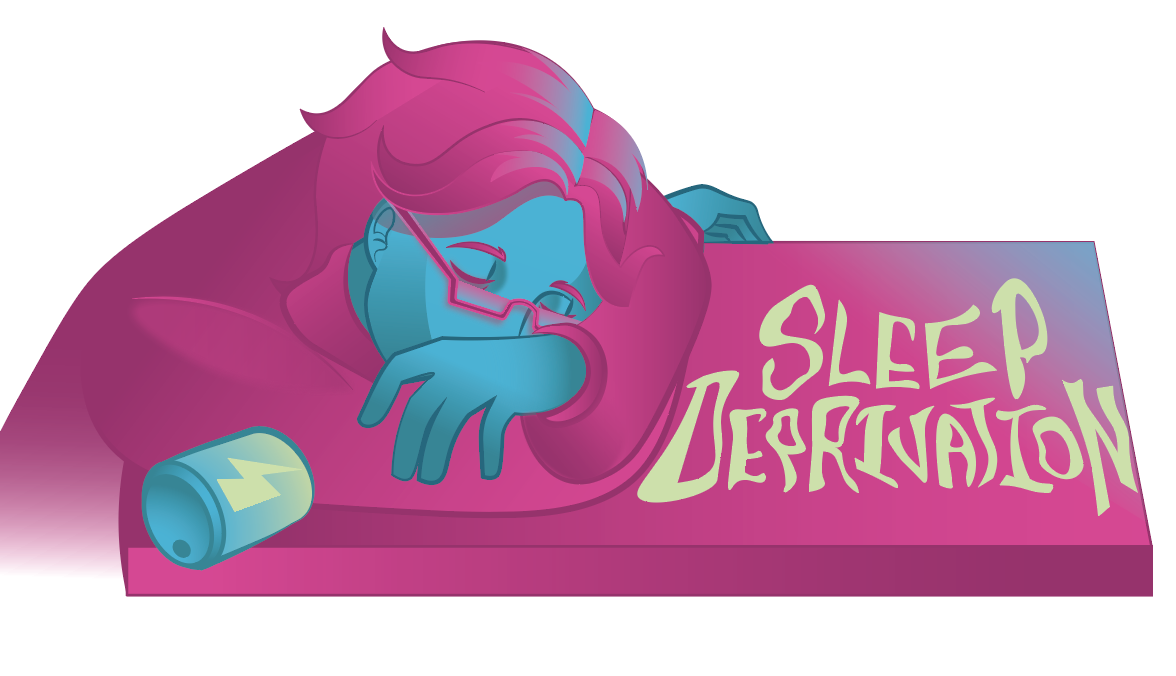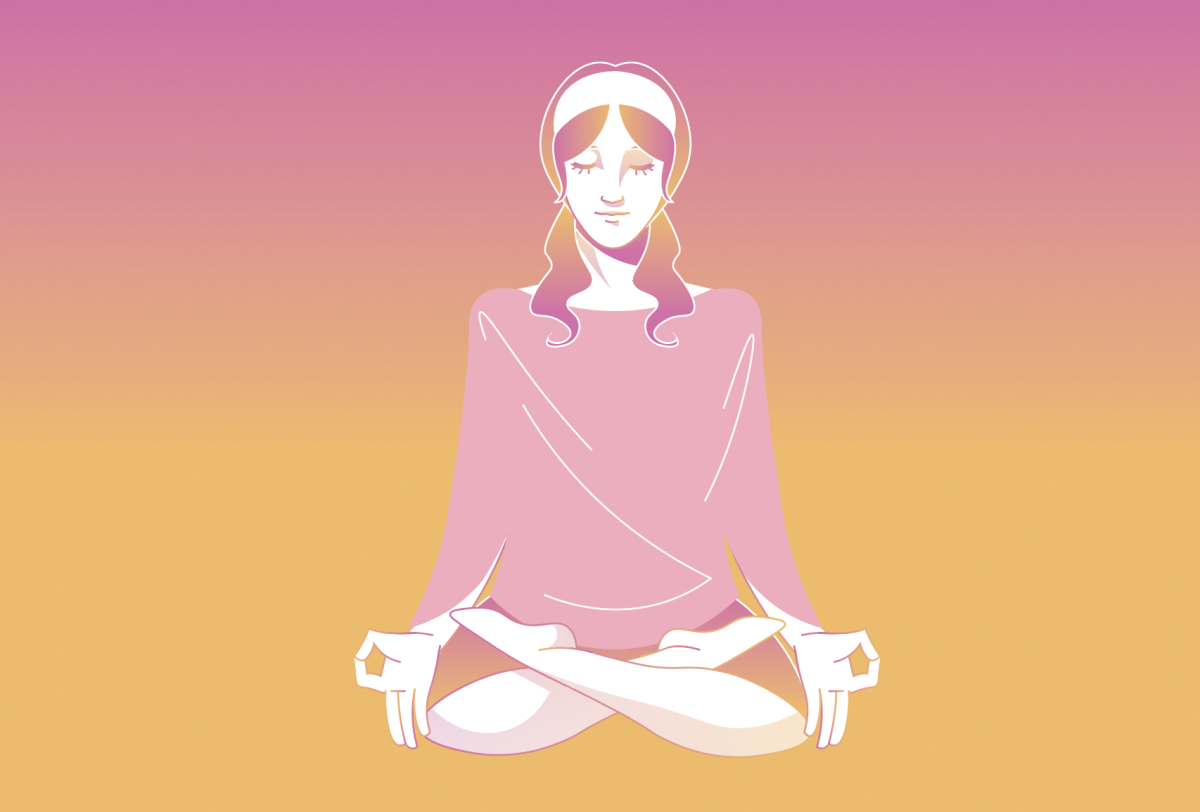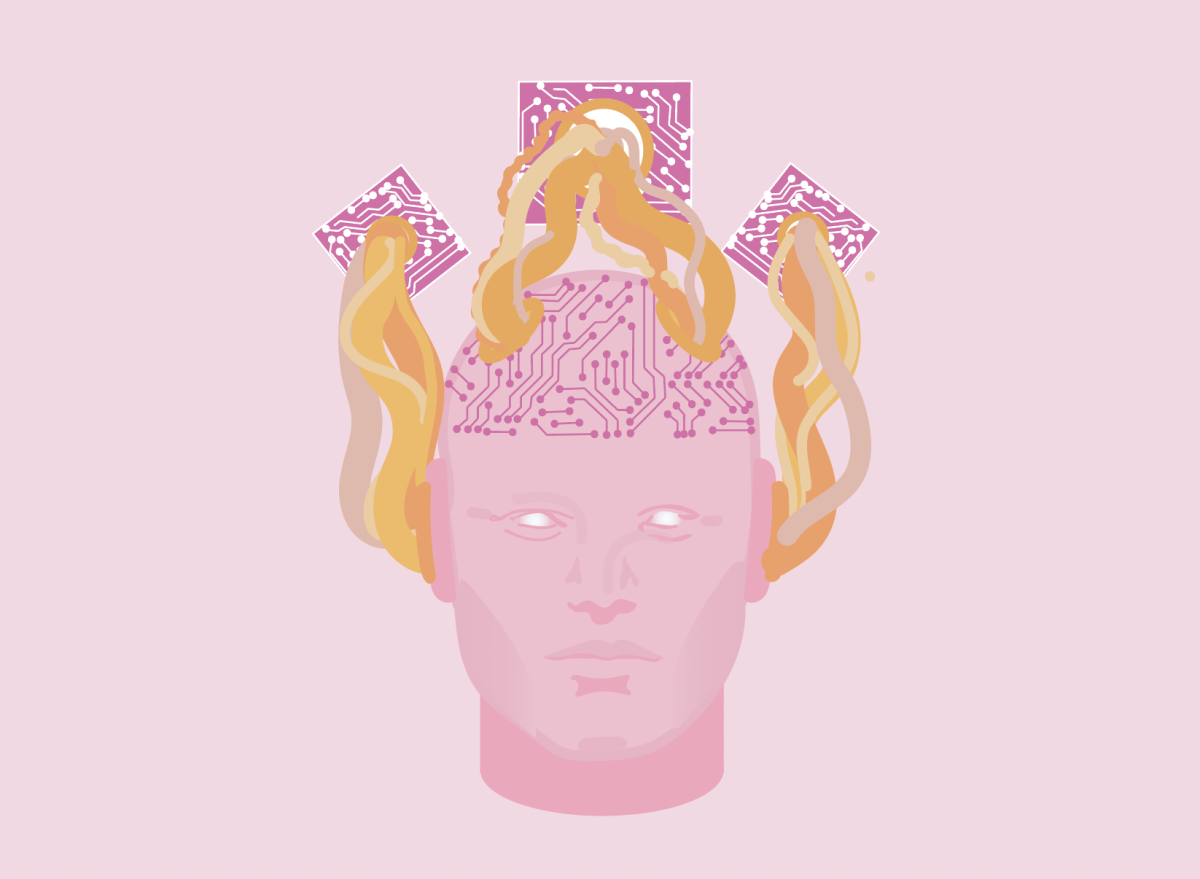Junior Imaan Dadabhoy rolls out of bed to the sound of her alarm. She glares at the bright phone screen, blinding in the dark room she lays in. She shuts down the alarm. Sitting up, she taps on the screen, opening Instagram.
With the rise of social media, Dadabhoy uses them all. TikTok, Snapchat, Instagram, Twitter, BeReel, even Facebook. She was sucked into these apps, fueled by the desire to stay connected with everyone in her community.
“Social media has been a good thing for finding more people to talk to and connecting with people who I haven’t seen in a long time,” Dadabhoy said. “But, at the same time, I feel like it’s had a big, negative effect on my mental health. It creates new insecurities for me, and I waste so much time on it, when I could be doing better things for myself.”
THE HISTORY
Social media finds its roots in 1997, with the release of the first platform, SixDegrees. The rise in popularity became apparent in 2004, the year that MySpace became the first social media site to get a million monthly users. AP Psychology teacher Kristina Grandinetti-Johnson remembers the first social media she ever installed: Facebook.
“I resisted it for a long time,” Grandinetti-Johnson said. “It wasn’t until an old high school friend called me, saying I need to get on Facebook, that I even considered using it. It’s fun because you’re connecting with people that you may have forgotten about, it’s nice to see how their life is going. That connectivity is a tremendous part of it, but it took time for me to come around.”
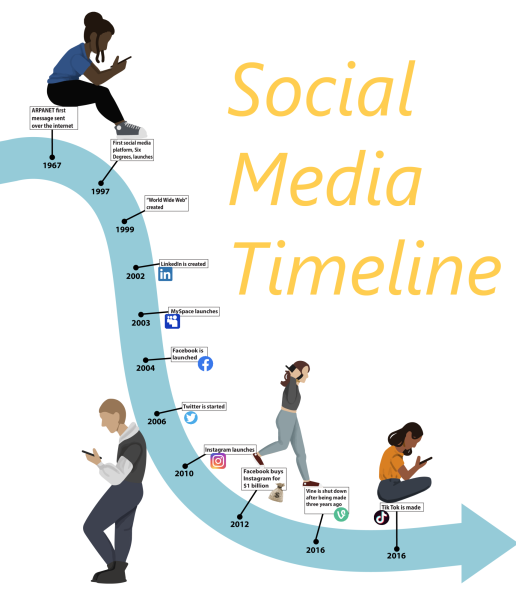
Not all platforms have experienced success, though. Sites like Hi5, MySpace, and Friendster were all once on Facebook’s level, but have since lost popularity. Modern apps face similar scrutiny; Dadabhoy has deleted Instagram on and off, unable to stay away for too long.
“I hate having social media, but addiction is a real thing,” Dadabhoy said. “It feels pointless, and Instagram especially creates new insecurities for me. It’s unhealthy for my mind but I can’t help but re-download it.”
Less than a generation ago, social media was unthinkable; now, it plays a role in the everyday life of one-third of the world’s population. Growth in popularity is matched by the release of new platforms. TikTok launched in September of 2016, but by mid-2018, it already had half-a-billion users. Sophomore Avery Solis believes TikTok plays a large role in what she feels is the largest mental health crisis in history
“I love TikTok, and I like how easy it is to find happy, funny videos on it,” Solis said. “But it causes mental health problems, especially with our generation. Doomscrolling is so damaging, but I can’t help but do it, because of how addictive TikTok’s little videos are.”
STUDENT OBSESSION
Teens make up the majority of modern social media users. According to the American Academy of Child and Adolescent Psychiatry, over 90% of teens ages 13-17 use social media regularly. At Bowie, Grandinetti-Johnson believes the apps distract students in the classroom.
“I can’t even imagine how many times I’ve told a student to put away their phone,” Grandinetti-Johnson said. “Every time I address the class, I need to call out to specific students to tell them to put their devices away.”
Because social media is still relatively new, it’s not clear what factor plays the largest role in teen obsession. Senior Chris Abarca believes younger people use media to discover new trends. Dadabhoy believes peer-pressure plays a larger role. She wonders if teens will continue with their use as they mature.
“As we grow up, I think we’ll use social media less and less,” Dadabhoy said. “We’ll be much more busy, having a life, putting food on the table, paying the bills. We won’t have time for it. We may use some of them, but definitely not all the ones we use right now.”
There’s a difference between social media use and social media addiction. Addiction is characterized by excessive media consumption, a reliance on social media to feel good, and an inability to stop obsession despite detriments to a student’s personal, physical, and social lives.
“I don’t know how many people at Bowie are actually addicted, but it’s scary either way,” Solis said. “Knowing that it’s possible that me or my friends could get chained to these apps is pretty freaky, because that would affect our lives in a lot of ways.”
As a coping mechanism, social media can leave users feeling empty, jealous of, or frustrated with what they see. To fight addiction, they can replace social media with more effective coping mechanisms, like mental and physical activity. When she’s stressed, senior Maddy Marino turns to art.
“After I deleted my accounts, I had more time to spend on my hobbies,” Marino said. “When I got stressed, instead of going online, I worked on my crochet projects. I’m so proud of how far I’ve come with my crochet skills, and spending time off social media helped me.”
Social media stands on pillars that capitalize on teen’s attention. Algorithms are a way to organize a person’s feed based on relevancy, so users see content related to their interests, inciting them to continue using the app. Developers design algorithms to be addictive, so users see more ads on the app, therefore making the company a profit. To control intake, Grandinetti-Johnson suggests students set screen time limits to avoid getting “sucked in” to the online world.
“Social media is a representation of everything wonderful and good about humans, and everything horrible and bad about humans,” Grandinetti-Johnson said. “There’s an addictive quality to it, but there’s much more to it than just addiction: when you spend more time on your screen, you’re interacting with real life people far less, which is ultimately bad for humans as a social species.”
Algorithms also capitalize on users’ self-esteem, as they incentivize excessive editing and unrealistic depictions of daily life. Instagram has caught criticism for its effects on users’ body images, as studies indicate that Instagram hurts self-esteem for one in three teenage girls, and that 6% of teens who reported suicidal thoughts traced those feelings back to Instagram; Marino has experienced this first-hand.
“When I was on Instagram, I always compared my own life to what I was seeing,” Marino said. “It made me feel ugly, like my life was so much more boring than others. I knew that the posts weren’t realistic, but it was hard not to let it get to me.
MENTAL HEALTH
Dadabhoy wasn’t born in Texas; she moved from Seattle to Austin last year. She believes social media plays a helpful role in allowing her to stay connected with friends who still live far up north in Washington.
“Instagram and Snapchat are my main forms of communication with the friends I left behind in Washington,” Dadabhoy said. “I’m glad I’m able to stay connected with them, even though I live far away from them.”
As Solis continues to recover from quarantine, she found social media necessary to connect with others, having been locked away throughout the COVID-19 pandemic. Social media has also been helpful for those who have limited independence, or suffer from social anxiety that limits them from making connections.
“I definitely think that different outlets of social expression is positive, but it’s not healthy to use social media to avoid addressing deeper issues,” Abarca said. “Using it to ignore your social anxiety is worse than doing nothing at all.”
Not all aspects of social media are positive, however. Young adults who use social media are three times as likely to suffer from depression, making suicidal thoughts and behaviors more common than they may be.
“Social media worsens mental health because it creates new insecurities for us,” Dadabhoy said. “They show you influencers who flaunt a curated lifestyle, who edit their photos to the point it gives us unrealistic expectations of our bodies and our lifestyles.”
Social media removes the barriers between the user and audience. Grandinetti-Johnson believes this can influence people’s decision-making, causing them to act on impulse, and post things they may regret later. This also leads to a rise in cyberbullying.
“There’s so much negativity and hate online,” Grandinetti-Johnson said. “People feel like they can say whatever they want, and pass whatever judgment they want, criticizing and commenting on stuff that’s really none of their business, just because they can get away with it. You don’t see who they are, but they can go into somebody else’s life and just spew hatred.”
Grandinetti-Johnson believes it’s not the social media that decides how someone’s mentality is affected, but their personal outlook that decides how they perceive what they see online.
“If you pay attention to the negative, you’re going to hear everything that you think is negative, disparaging, insulting, whatever it may be,” Grandinetti-Johnson said. “When you’re using social media, you’re going to hear and see more negativity. But if you have a tendency to balance that, not see as much of it, you’ll be happier online.”
Grandinetti-Johnson questions whether the blame for the online mental health crisis lies on social media, or if the root of our problems stem from personal outlook, rather than any external factors. She believes working to change sites’ algorithms can similarly change user’s happiness with time spent on screens.
“Social media adds another log to the fire, but it’s not necessarily what creates a problem,” Grandinetti-Johnson said. “It can make it worse or make it better. I don’t think it creates as many new problems as we think it does, our issues mainly lie in our own human tendencies.”
THE FUTURE
Social media has experienced rapid growth in the past few decades, and Grandinetti-Johnson doesn’t expect it to stop soon. The future of social media will be shaped by advances in technology, developments in the industry, and the growing role of technology on creating connections.
“Social media will continue to grow bigger and bigger, because our reliance on it is growing,” Dadabhoy said. “Advertisements are shifting from magazines to ads on your TikTok page. We do our shopping online, and now our knowledge of businesses are on our phones, too.”
The future of social media is limited only by the imagination of its creators; changes in society will contribute to these transformations. Humans are social creatures, and as people like Grandinetti Johnson, Dadabhoy, Solis, Abarca, and Marino continue on their social journeys, they can expect social media to evolve with them.
“I hope social media grows in a positive way, where we can all use it and be happy with it,” Solis said. “It’ll take a lot of work, but I think we can make the online world more accepting if we focus on making apps more positive.”
Abarca believes it’s important to take a step back and analyze the role of social media in teenager’s lives. In her own life, Dadabhoy thinks social media can have a positive impact on teens’ lives, as long as it’s used to lift oneself up, developing and growing someone into a better person than they were before.
“It’s really important to figure out if social media has a positive or negative impact on your life,” Dadabhoy said. “Identifying the ways it affects you can help you restructure your life in a way that makes you happier. It can help you grow into a stronger, smarter, better person.”
Grandinetti Johnson wants students to look at the way they use their devices, and ensure they’re using them as a tool for their own happiness, and not using them to seek topics that endanger them or their states of mind.
“Bad things are always going to happen,” Grandinetti-Johnson said. “That’s the nature of the game. You’re not going to live pain-free, nobody does. But are you constantly looking for beauty? Or are you constantly looking for pain?. If you’re focused on suffering, your confidence will hurt from that. You can control what you focus on, and you need to teach yourself to look for beauty.”



